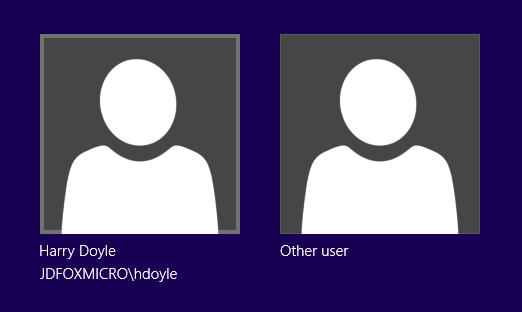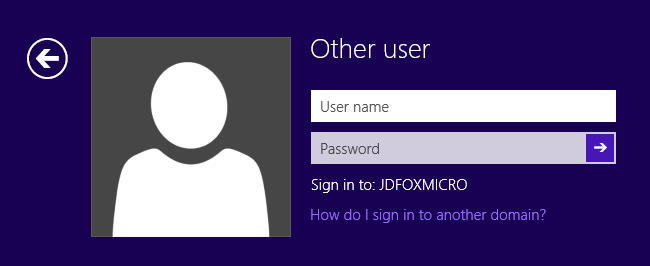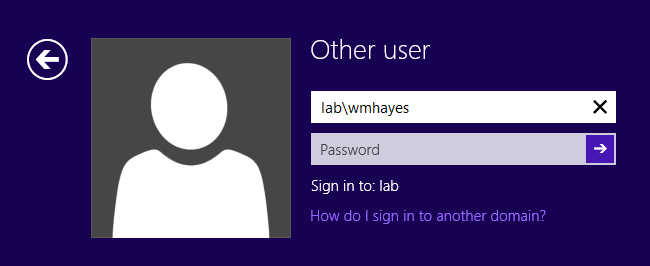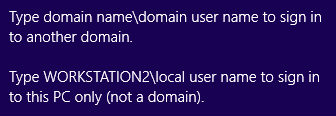Microsoft Windows 8 Sign-in and Domains
![]() The articles about logging on and off of Microsoft Windows have been among the most popular in the J.D. Fox Micro Resource Center. While the original articles covered every recent version of Windows, Windows 8 brought enough changes that an entirely new series of articles was necessary. Any reference to Windows 8 in this article applies to both Windows 8 and Windows 8.1.
The articles about logging on and off of Microsoft Windows have been among the most popular in the J.D. Fox Micro Resource Center. While the original articles covered every recent version of Windows, Windows 8 brought enough changes that an entirely new series of articles was necessary. Any reference to Windows 8 in this article applies to both Windows 8 and Windows 8.1.
![]()
![]()
![]() Click here for the edition of this article for Windows 7 and earlier.
Click here for the edition of this article for Windows 7 and earlier.
Introduction
On a Microsoft Windows based business network, a set of computers, shared folders, shared printers, and a list of authorized users and security polices which are all managed together is collectively called a Windows domain, an Active Directory domain, or, most commonly, just a domain.
When you sign in to a Windows-based computer that's part of a domain, your computer will check your user name and password against the list of users stored on a type of server called a Domain Controller, also referred to as a logon server. The Domain Controller then grants you access to the shared folders and printers that your domain user account is authorized to use.
All Windows-based computers also have what are called local user accounts. These are user names and passwords that are known only to your particular computer. You can manage these user accounts in your computer's Control Panel. If your computer is not part of a domain, these are the only accounts you can use to sign in. When your computer is part of a domain, you can either sign in with a domain account or using a local user account. While virtually no regular users on a domain network will ever need to sign in with a local account, it's important to be aware that this is possible.
Anyway, on a computer that is a member of a domain, Windows shows what we will call your sign-in context at the initial logon screen. This specifies where the user account you're going to sign in with is located. So, it will show either the name of a Windows domain, or the name of your computer (which would mean local user accounts). If you enter your user name and password, but the wrong context is specified, Windows will simply tell you that your user name or password is wrong. Windows only checks with the context specified to see if your user account is there and to validate your password. The only way to sign in successfully, then, is to make sure the specified sign-in context is correct.
Most networks are set up under one domain, and never have problems with a user selecting the wrong sign-in context. Once each computer is properly joined to a single-domain network, the sign-in context is set to that domain, by default, for every user who tries to sign in. As a result, many users on a stable business network never have problems related to selecting the correct domain.
That said, for users on a multiple-domain network, here is some information on how to deal with potential sign-in problems related to having the wrong logon context selected on the initial Windows logon screen.
How to Change Your Sign-In Context
If you already see your name because you were the last one to use the computer, the sign-in context will precede your name, separated by a backslash. Below, the user hdoyle is in the JDFOXMICRO domain.

If you were not the last to sign in, you must click or tap Other user to type your user name. There, you will see Sign in to and then the name of the domain that Windows will look to for your user account, just below the password box, as shown below. If this is correct, then you only need to type your user name like usual.

To sign in through a different domain, manually type the domain name with your user name, using the syntax DOMAIN \ USERNAME. In the example below, user wmhayes is signing in using an account on the LAB domain. Note the use of the backslash, which is usually above the Enter key on your keyboard. As soon as you hit the backslash key, Windows knows you're specifying a domain name, and the Sign in to item will change to show what you've typed.

Notice that domain names and user names on Windows networks are not case-sensitive.
If you ever do find yourself having to log on to a domain user account using a computer in a different domain, you will need to type your domain name every time. You cannot simply select it from a list like you could in Windows XP and earlier.
You'll notice there is a link labeled "How do I sign in to another domain?" on the above screen. If you click or tap this, you will get this message, which reveals that this particular computer's name is WORKSTATION2.

Microsoft's terminology in this window is imprecise and confusing. It incorrectly implies that you aren't signing in to the computer if you sign in through another domain. The whole point of all the screens and functions covered so far in the article, though, is to sign in to a computer, which is what you're doing whether you use a domain user account or a local user account. Microsoft also ignored the fact that you can just type a period as a substitute for the computer name. The message in the little box above should really say something like this:
To sign in to this computer using an account from a domain other than the default domain, include the domain name in the user name box using this syntax: domain\username.
To sign in to this computer using a local user account, precede your local user name with a period and backslash, like this: .\username.
There are more quirks you might discover on this particular sign-in screen, particularly related to local user accounts. But, these are beyond the scope of this article, which is meant to focus on signing in to the proper domain account on a standard business network.